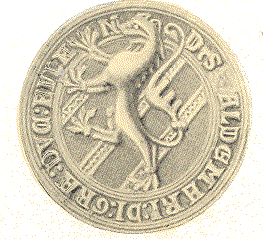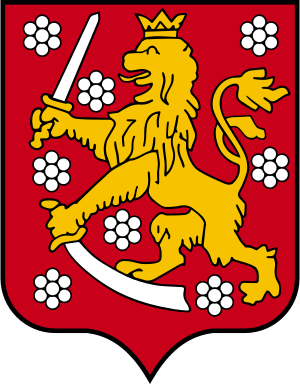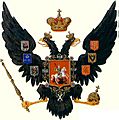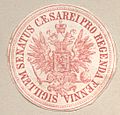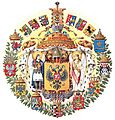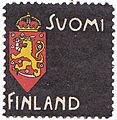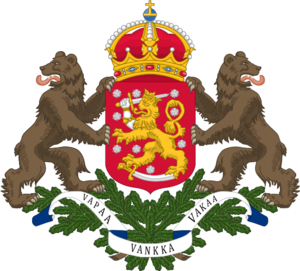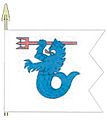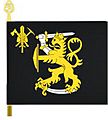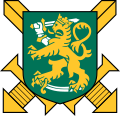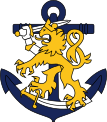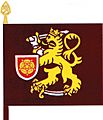Coat of arms of Finland facts for kids
The coat of arms of Finland shows a crowned lion on a red background. The lion's right front paw is an armored human arm holding a sword. Its back paws are stepping on a sabre (a type of curved sword). This coat of arms was first made around the year 1580. The current official version has been used since 1978.
Quick facts for kids Coat of arms of Finland |
|
|---|---|
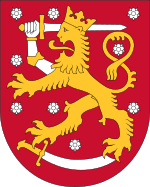 |
|
| Versions | |
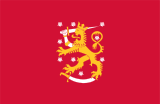
The banner of arms, which served as state flag from December 1917 to May 1918
|
|
| Armiger | Republic of Finland |
| Adopted | First documented in the 1580s. Current version official since 1978. |
| Blazon | Gules, sémy of nine roses Argent, a crowned lion rampant Or armed of the same trampling a sabre Argent hilted and pommeled Or, his dexter foreleg in the form of an arm in armour Argent garnished Or bearing aloft a sword Argent hilted and pommeled Or. |
Contents
History of the Finnish Coat of Arms
The Lion in Old Coats of Arms
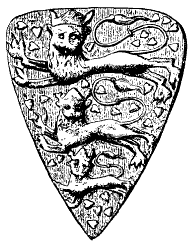
Lions are often seen in coats of arms across Western Europe. Many countries use a lion in their national symbols. In Nordic countries like Scandinavia, the lion first appeared in the coat of arms of Denmark in the late 1100s.
Around the 1200s, the land that is now Finland slowly became part of the Swedish kingdom. This was also when coats of arms started to be used in northern Europe. The first time a lion was used in Sweden was on the royal seals of King Erik Knutsson (who died in 1216) and King Erik Eriksson (1216–1250). They used two and three lions on their seals. The first king from the House of Bjelbo, Valdemar Birgersson (1239–1302), also used three lions on his seal (Figure 2).
Finland as a Duchy
The first two Dukes of Finland, Bengt Birgersson (Duke from 1284 to 1291) and Valdemar Magnusson (Duke from 1302 to 1317), both used the Folkunga coat of arms. This coat of arms showed a crowned lion with three diagonal stripes. Valdemar's version also had small hearts scattered around (Figure 3). This old version was quite similar to Finland's modern coat of arms. However, the lion did not yet hold any weapons.
How the Coat of Arms Was Created
When John III became "Grand Duke of Finland and Karelia" in 1577, the lion became a symbol for Finland. This grand-ducal coat of arms (Figure 5) likely combined the Göta lion (from the Folkunga lion) with the arms of Karelia (Figure 6). This is how the lion ended up holding one weapon and stepping on another.
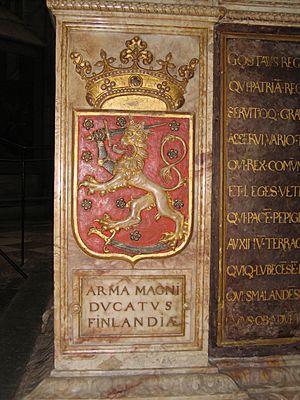

The most famous version of this grand-ducal coat of arms is on the tomb of Gustavus I (1523–1560) in the Uppsala cathedral (Figure 5). It is thought that either Duke John or his brother Eric XIV helped design the symbols on the tomb. The tomb was made by Guillaume Boyen, a sculptor from Flanders. He started working on it in 1562 and finished 10 years later. The tomb was placed in Uppsala in the early 1580s.
The earliest description of the Finnish coat of arms from this time says: "A crowned lion of gold holding a sword in its right front paw and stepping with both back paws on a Russian sabre. It is surrounded by nine silver roses on a red background. Above the shield is a golden crown with a red cap."
Since King Gustavus I and his son, John III, were often at war with Russia, it's not surprising that the sabre was included. It symbolized the struggle between the East and West. This symbol was also seen in the coat of arms of the Finnish province of Karelia (Figure 6).
The reason for the nine roses is not fully known. Most people now think they are just for decoration. Some have suggested they represent the nine historical provinces of Finland, but this idea is not widely supported by experts.
How the Coat of Arms Changed Over Time
During the Swedish Era
Over the next few centuries, the Finnish coat of arms appeared in many different artistic styles. It wasn't until the late 1800s that the "Uppsala lion" (from Gustav I's tomb) was used again as the main design.
The lion changed several times in the 1600s. For example, in the funeral banner of Charles X Gustavus (in 1660), the lion was shown stepping on the sabre with all three free paws. In drawings by Elias Brenner (from a book printed in 1716), the lion had a double tail and looked almost like it was walking.
-
Coat of arms of Finland in the chronicle of Laurentius Petrin from the 1580s.
-
Coat of arms of Finland from the funeral procession of Gustav II Adolf from 1633.
During the Russian Era
After Finland became part of Russia in 1809 (after a war between Sweden and Russia), Elias Brenner's version of the lion was chosen for the new coat of arms of the Grand Principality of Finland. The official description from 1809 said: "The shield has a red background, with silver roses. On it is a golden lion with a golden crown, standing on a silver sabre, which it holds with its left front paw while holding an upright sword in its right front paw." At this point, the idea of the lion "trampling on a Russian sabre" was no longer part of the meaning.
In 1857, during a reform of Russian official symbols, the lion was changed again. The new description said: "On a red background with silver roses, a crowned golden lion, holding an upright sword in its right front paw and a curved sword in its left, on which it rests with its right back paw." The main changes were that the lion started to look more like a dog, and the crown on the shield was changed to an arched crown with a small Russian eagle on it. The sword in the right front paw also became much smaller, looking more like a dagger (Figure 8).
During the time when Russian emperors tried to make Finland more Russian (1899–1905 and 1908–1917), the use of Finland's coat of arms became much more common and popular among the people.
Karl Bomansson (1827–1906), who was the director of the Finnish National Archives, did the first important study on Finland's arms in modern times. In 1886, he brought back the look of the "Uppsala lion." However, there was a small difference in how the lion stepped on the sabre. Also, the arched crown with the imperial eagle was replaced with a crown similar to a German princely crown. This version was then used in the early years of Finnish independence.
-
Coat of arms of Finland from the throne of Emperor Alexander I used in the Diet of Porvoo from 1809.
Early Independence
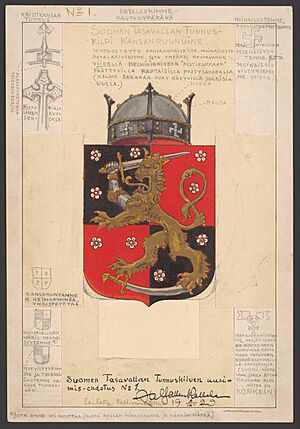
In the 1920s and 1930s, there was some debate about the national coat of arms. Some people thought the lion should be replaced with a bear. Bears were important in Finnish folklore. However, outside Finland, the bear was often seen as a symbol of Russia. So, the debate was not settled. For most of the 1900s, versions of the arms that looked like the "Uppsala lion" were used.
In 1936, a state committee suggested that Finland should have a "greater" and a "smaller" coat of arms. The "greater" coat of arms would have two bears holding up the shield (Figure 9). It would also have spruce branches at the bottom and the motto vapaa, vankka, vakaa ("free, firm, steadfast"). This would have given the bear a place in the national symbols, but this design was never officially approved or used.
The Coat of Arms Today
The official description of Finland's national coat of arms was finally set in 1978. The law from May 26, 1978, describes it as: "On a red field, a crowned lion. Its right front paw is replaced with an armored hand holding a sword. It is trampling on a sabre with its back paws. The lion, crown, and weapons are gold. The blades and armor are silver. The field is scattered with nine silver roses."
The coat of arms appears on the Finnish state flag. The Finnish lion is also used in many symbols for different government groups. These symbols are often changed slightly to show what the group does. For example, the Artillery Brigade has a lion holding a cannon. Finnish cities and regions usually use different symbols, keeping the lion for state use. The Finnish lion is also part of the rank symbols for generals in the armed forces and for officers in the navy.
Images for kids
-
Finnish Army: Finnish coat of arms with jaeger green escutcheon placed upon crossed swords.
See also
 In Spanish: Escudo de Finlandia para niños
In Spanish: Escudo de Finlandia para niños
- Flag of Finland
- Finnish national symbols
- Armorial of sovereign states



